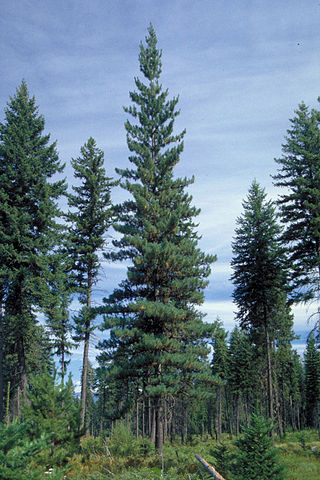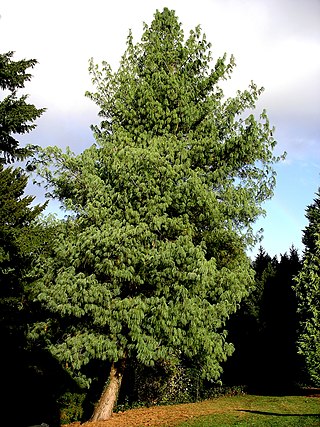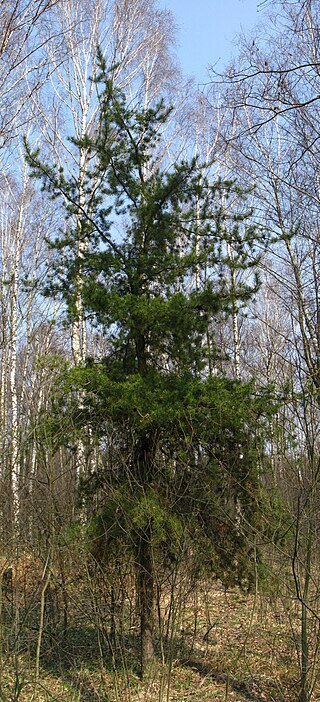
Pinus sylvestris, the Scots pine (UK), Scotch pine (US) or Baltic pine, is a species of tree in the pine family Pinaceae that is native to Eurasia. It can readily be identified by its combination of fairly short, blue-green leaves and orange-red bark.

Choristoneura is a genus of moths in the family Tortricidae. Several species are serious pests of conifers, such as spruce and are known as spruce budworms.

Western white pine, also called silver pine and California mountain pine, is a species of pine in the family Pinaceae. It occurs in mountain ranges of northwestern North America. It is the state tree of Idaho.

Pinus nigra, the Austrian pine or black pine, is a moderately variable species of pine, occurring across Southern Europe from the Iberian Peninsula to the eastern Mediterranean, on the Anatolian peninsula of Turkey, Corsica and Cyprus, as well as Crimea and in the high mountains of Northwest Africa.

Pinus jeffreyi, also known as Jeffrey pine, Jeffrey's pine, yellow pine and black pine, is a North American pine tree. It is mainly found in California, but also in the westernmost part of Nevada, southwestern Oregon, and northern Baja California. It is named in honor of its botanist documenter John Jeffrey.

Pinus flexilis, the limber pine, is a species of pine tree-the family Pinaceae that occurs in the mountains of the Western United States, Mexico, and Canada. It is also called Rocky Mountain white pine.

Pinus contorta, with the common names lodgepole pine and shore pine, and also known as twisted pine, and contorta pine, is a common tree in western North America. It is common near the ocean shore and in dry montane forests to the subalpine, but is rare in lowland rain forests. Like all pines, it is an evergreen conifer.

Pinus wallichiana is a coniferous evergreen tree native to the Himalaya, Karakoram and Hindu Kush mountains, from eastern Afghanistan east across northern Pakistan and north west India to Yunnan in southwest China. It grows in mountain valleys at altitudes of 1800–4300 m, reaching 30–50 m (98–164 ft) in height. It favours a temperate climate with dry winters and wet summers. In Pashto, it is known as Nishtar.

Jack pine is an eastern North American pine. Its native range in Canada is east of the Rocky Mountains from the Mackenzie River in the Northwest Territories to Cape Breton Island in Nova Scotia, and the north-central and northeast of the United States from Minnesota to Maine, with the southernmost part of the range just into northwest Indiana and northwest Pennsylvania. It is also known as grey pine and scrub pine.

Pinus leiophylla, commonly known as Chihuahua pine, smooth-leaf pine, and yellow pine, is a tree with a range primarily in Mexico, with a small extension into the United States in southeast Arizona and southwest New Mexico. The Mexican range extends along the Sierra Madre Occidental and Sierra Madre del Sur from Chihuahua to Oaxaca, from 29° North Lat. to 17°, between 1600 and 3000 meters altitude. It requires about a rainfall 600 to 1000 mm a year, mostly in summer. It tolerates frosts in winter.

Pinus gerardiana, known as the chilgoza pine or neja is a pine native to the northwestern Himalayas in Afghanistan, northern Pakistan, Waziristan and northwestern India, growing at elevations between 1800 and 3350 metres. It often occurs in association with Cedrus deodara and Pinus wallichiana.
Resin acid refers to mixtures of several related carboxylic acids, primarily abietic acid, found in tree resins. Nearly all resin acids have the same basic skeleton: three fused rings having the empirical formula C19H29COOH. Resin acids are tacky, yellowish gums that are water-insoluble. They are used to produce soaps for diverse applications, but their use is being displaced increasingly by synthetic acids such as 2-ethylhexanoic acid or petroleum-derived naphthenic acids.

Choristoneura occidentalis is a species of moth of the family Tortricidae. It is found in the Democratic Republic of Congo, South Africa, Tanzania and Gambia.

Spruce-pine-fir (SPF) is a classification of lumber that can be traded on commodities exchanges.

Choristoneura murinana is a moth of the family Tortricidae. It is found in central Europe and the Near East, China, Taiwan and in North America.

Choristoneura conflictana, the large aspen tortrix, is a moth of the family Tortricidae. The species was first described by Francis Walker in 1863. It is found from the Pacific to the Atlantic coast and from Alaska to California, Arizona, and New Mexico.

Choristoneura lambertiana, the sugar pine tortrix, is a moth of the family Tortricidae. It is found in the eastern parts of North America and the northern regions of the United States.

Choristoneura rosaceana, the oblique banded leaf roller or rosaceous leaf roller, is a moth of the family Tortricidae. It is native to North America, but has been accidentally introduced into other parts of the world.
Argyrotaenia occultana, the fall spruce needle moth, is a moth of the family Tortricidae. The species was first described by Thomas Nesbitt Freeman in 1942. It is found in North America, where it has been recorded from British Columbia north to Yukon and Northwest Territories, east to Newfoundland and south to Kentucky and Oregon. The habitat consists of spruce forests.
Choristoneura zapulata, the zapulata moth, is a moth of the family Tortricidae. The species was first described by Robinson in 1869. It is found in North America, where it has been recorded from British Columbia to Quebec, south to California, Illinois and Pennsylvania.






















